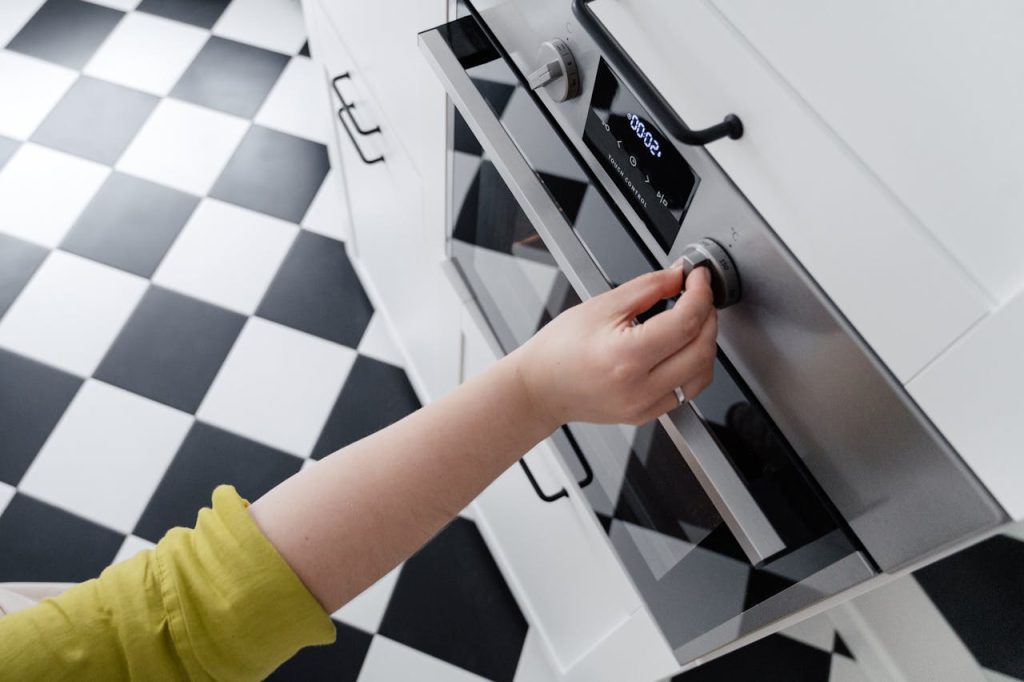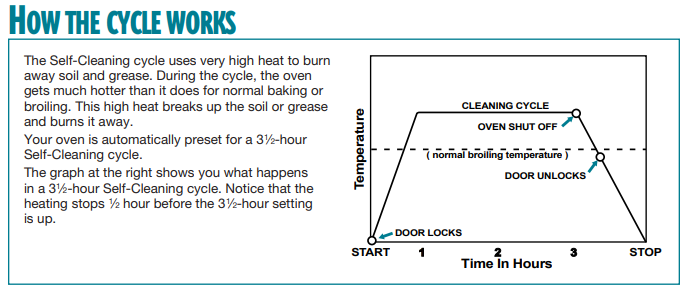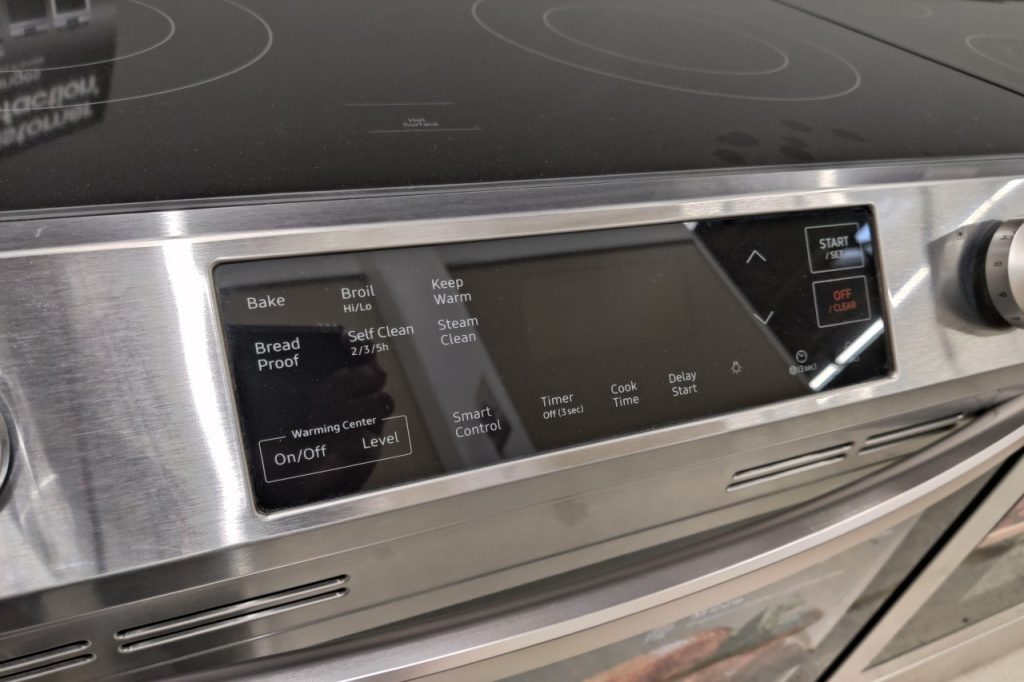Using the self-cleaning feature on your oven may seem like a good idea. Here is why you should avoid it at all costs.

It can be tempting to hit that self-clean button on your oven that’s beckoning to you after seeing the baked-on disaster awaiting you after making barbecue baked beans in your oven last night for dinner.
After all, the self-cleaning function must be safe since it’s built into the oven. The manufacturers must have designed the oven with customers using the feature in mind, right?
It might better make sense to avoid that button altogether to avoid a costly bill.
I know two people whose ovens needed repairs or replacement after using the self-cleaning feature. You’ll find many similar stories posted online by people who have experienced the same thing.
Table of Contents
How Do Self-Cleaning Ovens Work
Self-cleaning ovens work by turning baked-on food and grease into ash using extremely high heat – as much as 1,000 degrees Fahrenheit in some ovens. A cleaning cycle will usually take between 2 to 5 hours to complete.

In comparison, the high-temperature broil setting usually hits 500 degrees.
Ovens designed with the self-cleaning function often have heat-resistant porcelain enamel oven walls on the interior and extra insulation for safety.
The oven door will automatically lock when the cleaning process begins to prevent injuries and won’t unlock until the temperature drops below 600 degrees.
After the cleaning process, all that should remain is a powdery ash that you can wipe away.
Why You Should Avoid Self-Cleaning the Oven
Here are a few reasons why you should not use the built-in cleaning function on your oven.

It Can Damage Your Oven
When you are running an oven at very high temperatures for an extended time, it can result in something becoming damaged. This is no different than running a car’s engine at redline non-stop. Eventually, something is going to break.
Your new oven isn’t likely to be damaged the first few times you use the self-cleaning function. The result will be additional wear and tear on the stove. Over time, this adds up and can lead to a costly repair bill. Murphy’s Law says if something is going to break, it will break when the warranty is up.
Parts likely to have problems include the oven door’s locking mechanism no longer working. The electronic touch control panels get fried since they are often located above the oven’s vents. The oven’s thermostat could go bad. Thermal fuses can burn out. These will have to be replaced before the oven functions again. Wires can short or melt. Circuit boards can go bad since common high-temperature solders have a melting point of 570 F. The high temperatures have caused oven glass to crack.
It Causes Smoke and Harmful Fumes
The self-cleaning function aims to incinerate any food spills and grease remaining in the oven. When anything burns, it creates smoke and combustion pollutants like carbon monoxide, ultra-fine particles, and hydrocarbons.
It is well known eating meats grilled at high temperatures can increase the risk of cancer. Burning of fat and charring of meat can produce cancer-causing chemicals known as heterocyclic amines (HCAs) and polycyclic aromatic hydrocarbons (PAHs). When you turn leftover food remnants in the oven to ash, you create smoke that can contain these harmful agents, spreading them throughout your kitchen and home.
Oven manufacturers instruct owners to use the kitchen exhaust fans and ventilate the room by opening windows to remove the smoke and fumes when self-cleaning their oven.
Pets, especially birds, need to be moved to another area of the house. To limit the spread of fumes, you should take the additional step of closing the doors to any of the other rooms.
Some people recommend going for a walk while the cleaning process is taking place. However, if you are hesitant to leave your iron on unattended, you may be cautious about leaving a super-hot oven on while you are gone.
It Is a Fire and Burn Hazard
During the self-cleaning process, the oven’s temperature can reach almost 1,000 degrees Fahrenheit. The stove gets so hot, that the self-cleaning directions from Whirlpool say to remove any plastic utensils on the stovetop because they may melt.
Such high temperatures may cause the surface of the stove to become a burn hazard. You will want to keep pets and children away from the stove while it is self-cleaning.
If that isn’t bad enough, one friend whose oven needed replacement after using the feature was told by the repairman that she was one step away from burning down the kitchen. There is only a thin sheet of metal separating the oven from the walls and cabinets in your kitchen as you run the oven at very high temperatures for hours on end.
Not only does the oven get hot inside, but all that extra heat will be heating your house. That would be okay in the cooler months. Summer means extra work for the A/C and money for keeping your house cool.
It Might Not Work As Well As You Would Think
The self-clean feature does not mean you can simply start it and let it run. You still need to prep the oven before starting the cleaning cycle.
It is recommended to wipe up loose food and grease before cleaning to reduce the smoke created.
Foods with sugar still need to be cleaned up each time after using the oven. When sugar is left in the oven, the high temperatures will cause the sugar to burn and react with the porcelain coating. This can cause staining and pitting on the coating.
It is best to remove the oven racks before starting the cleaning cycle or they can lose their luster. The oven racks can be cleaned in the oven but will need to be oiled afterward with vegetable oil so they will slide more easily on the tracks.
Heavy soiling may require a longer time or multiple self-cleaning processes to run. Baked-on stains may never come off older ovens.
How to Clean Your Oven Instead
Many chemical oven cleaners are available on the market, from Easy Off Oven Cleaner Spray to Goo Gone Oven and Grill Cleaner.
Before using a chemical oven cleaner product, check your oven’s manual for the manufacturer’s recommendations. Some self-cleaning ovens do not recommend using a chemical oven cleaner since it may permanently damage the enamel surface.
You can use common household products that are less aggressive and safer for you and the environment.
All you need to clean your oven is Dawn dish soap, dishwasher tablets, baking soda, and vinegar.
Cleaning the Oven Racks
First, remove the oven racks from the oven.
Soak them in the sink or bathtub in hot water with dish soap or dishwasher tabs for several hours or overnight to loosen any grime and stuck-on food.
Use a heavy-duty scouring pad to help remove any stuck-on messes.
Cleaning the Oven Interior
For the interior of your oven, create a paste using the Dawn dish detergent, baking soda, and vinegar.
Apply the mixture throughout the oven using a sponge or brush.
Using a spray bottle filled with more vinegar, spray down the interior of the oven. Take care to avoid getting vinegar on the heating elements. The elements on the bottom can usually be lifted slightly to make it easier to clean underneath.
Leave alone for a couple of hours or overnight.
Use a non-scratching scouring pad to scrub off any grease or remaining food.
Post-Oven Cleaning Tip
After cleaning the oven, you can buy silicon or Teflon oven liners to place on the bottom of your oven for easier future cleanup. These reusable liners are heat-resistant, non-stick, and easy to clean. They will catch any drips and spills that occur. You can wipe the oven liners clean if dirty or even place them in your dishwasher.
Closing $ense
It is your choice whether you use the self-cleaning option with your oven. Some people prefer the lower effort and time-savings that the set-it-and-forget-it option offers with the off-chance they might need to repair or replace the oven sooner.
Should you decide to use the self-clean feature, it is best to do it a few weeks before any important event or holiday when you’ll need the oven. You do not want to self-clean the oven the weekend before Thanksgiving.
Ignoring the need to clean the oven isn’t an option either. The dirtier your oven is, the more likely you will get smoke and odor when you use your oven. This can affect the taste and smell of foods baked in the oven. If the oven gets too filthy, it may not work as efficiently.
As with many things in life, regular cleanings are more beneficial than procrastinating until the food gets caked on over time, causing it to become a major chore to clean.
Have you had problems after using the self-cleaning function on an oven? Do you have any helpful tips for cleaning an oven?
